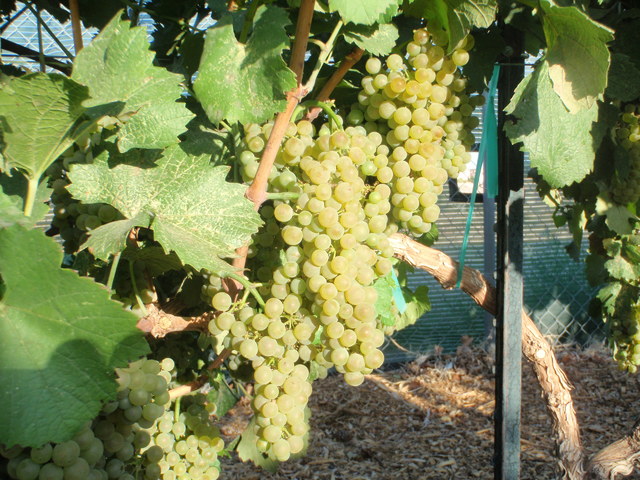Wood chips work best as mulch around grapevines
Q: I am putting in 30 more wine grapevines. I was thinking of using chat, crushed rock, for mulch rather than wood chips. What do you think?
A: The idea of using rock mulch, rather than wood chips, addresses a controversy among wine grape growers. Some growers of high-quality wine grapes believe that wine grapes must “struggle” to produce a good quality wine grape. They believe the best wine grapes come from poor soils and a limited water supply.
The hot desert, with nighttime temperatures around 90 F or hotter during harvest time, is thought to produce a poor quality wine grape. It is believed that nighttime temperatures should be cooler than this during harvest. Few people believe that a good quality wine grape can come from this type of environment.
Some of these same producers believe that soils for wine grapes should not be full of nutrients. Adding compost or soil amendments that improve the soil, they believe, produces a grape without intense flavor typical to the variety, a poorer quality grape.
The verdict is still out, but I believe that wine grapes struggle enough in our climate and soils without additional stress from poor soils and a lack of water. I have seen wine grapes grown in backyards in our climate without soil amendments. The soils around the home, in these cases, was “fill dirt” specified by the contractor. In most cases, these did poorly.
I have seen wine grapes grown in our climate in native soil, with no organic surface mulch such as wood chips. These did much better. I might point out that in cases like these the soil was a good agricultural desert soil, not “fill dirt.”
I have concerns about growing wine grapes in home landscapes if the home is surrounded with fill dirt. I believe this soil should be amended at the time of planting, and the soil surface should be covered with an organic mulch, such as wood chips. I am concerned that applying rock mulch, like chat, to its surface will lead to future problems for wine grapes and many other landscape plants sensitive to poor soils and not intended for our climate.
Q: When should I put tulip bulbs in the fridge so that they bloom on Easter or a few days earlier. Can you please help me? I want a nice table centerpiece.
A: Getting tulips to bloom precisely at Easter is difficult for a homeowner because they frequently do not have enough information about the tulip or a precision growing environment.
Commercial growers using greenhouses get plants to bloom precisely on a specific date by selecting known varieties and growing them at precise temperatures. Some plants, such as mums and Christmas cactus, require controlling the length of darkness or the application of growth regulating chemicals at specific times.
Tulips are a little easier. Most tulip varieties bloom in four weeks if the temperature is kept constant at 60 F. Plants grow faster or slower depending on temperatures. Plants grow faster in warm weather and slower in colder temperatures. If tulips are grown 10 degrees warmer, 70 F, subtract a week. If grown 10 degrees cooler, 50 F, add a week.
A few varieties might take five to six weeks to bloom at 60 F. For precision blooming, it’s best to know the variety of tulip being grown and how many weeks it takes to bloom.
Some flowering plants require cold temperatures to bloom. We oftentimes have enough outside cold temperatures for tulips during winters in the Las Vegas Valley if they are planted on the north side of a building and in the shade. But it depends on the variety.
To vernalize tulips (subjecting the bulbs to cold temperatures so they produce flowers) the bulbs are placed in a refrigerator 12 to 14 weeks. They will grow a little bit, slowly, at this temperature. Some varieties of tulip require fewer than 12 to 14 weeks. Some tulip bulbs are available pre-chilled.
Here is how I would do yours. Stick the bulbs in the refrigerator, upright, in slightly moist potting soil for 14 weeks. At the end of 14 weeks, put them at room temperature five weeks before you want them to bloom.
If they are growing too fast, grow them colder; put them outside in the shade on the north side of the house to slow them down. When they are back on track, bring them back indoors. Water them when needed, but don’t keep the bulb wet.
The bulb can’t be dry, either. It can lose roots that way. Use a soil moisture meter to judge when to add water. Fertilize lightly once a month with a water-soluble fertilizer during warm temperatures.
Q: Have you done any experiments with gamma rays and X-rays applied to seeds attempting to mutate them into something different? I’m totally curious if this is at all done or just a neat idea.
A: Giving seeds some sort of radiation to mutate them into something better is a little bit like taking a Hyundai and smashing it into a brick wall hoping to get a Mercedes. This kind of research was tried by scientists not that long ago without much success. The mutations were all over the place.
Manipulation of a plant is focused on its DNA, or genes. When radiation is given to seeds, we do not know which part of the DNA, if any, is changed until they are grown. Just like the Hyundai example, the results can be highly variable.
Genetic engineering, on the other hand, is precise. If genetic engineering is successful, scientists must precisely understand the genetic information inside the plant.
Specifically, they must know exactly which gene controls which plant function. Genetic engineering changes a specific gene which in turn causes a plant to change, hopefully, in a predicted way.
This new, or changed, gene provides the plant with different guidance than before. When new genes are spliced into existing DNA, the plant responds differently according to which gene was changed. The result is a mutation, but scientists have a much more accurate guess as to how this new plant will act. Genetic engineering causes the “Hyundai” to become something different, maybe a pickup truck. This newer form of the same plant, scientists hope, will be an improved version of the old one.
People who are skeptical of this type of science, cautious or opposed to genetic engineering, are concerned this new plant might be something dangerous to human health, dangerous to other plants, to our environment or cause a result scientists have not anticipated.
Q: I cut down a mesquite tree I thought might lift my walkway leading to my residence. I was worried about waterlines and roots. Will the roots die or will they continue to grow?
A: If the mesquite tree was cut down so that its crown was removed (the part of the trunk at the soil surface and a little bit below), the roots should die. There are some trees which grow from the roots after they have been cut down, but most mesquite trees do not.
Roots of most mesquite trees do not sucker and continue to live after the tree was cut down. If you see no new growth from the roots after the tree was cut down, then the entire tree is dead and the roots will decompose in the soil.
If a short stump remains after the tree was cut down, consider taking a 1-inch wood bit and an electric drill and drill vertical holes as deep as you can in the remaining stump. Drill them within an inch of the outside bark. Drill as many as you can but put them no further than 1 inch apart.
It is not necessary to drill vertical holes in the center of the trunk because that wood is already dead. The only living part of the trunk is close to the bark.
Pour salt down these holes or copper sulfate to kill the crown or use diluted weedkiller if the label permits it. Some do, and some don’t. Read the label and it will tell you what the dilution should be, but it is usually the same dilution that is recommended for weed control.
Bob Morris is a horticulture expert living in Las Vegas and professor emeritus for the University of Nevada. Visit his blog at xtremehorticulture.blogspot.com. Send questions to Extremehort@aol.com.























